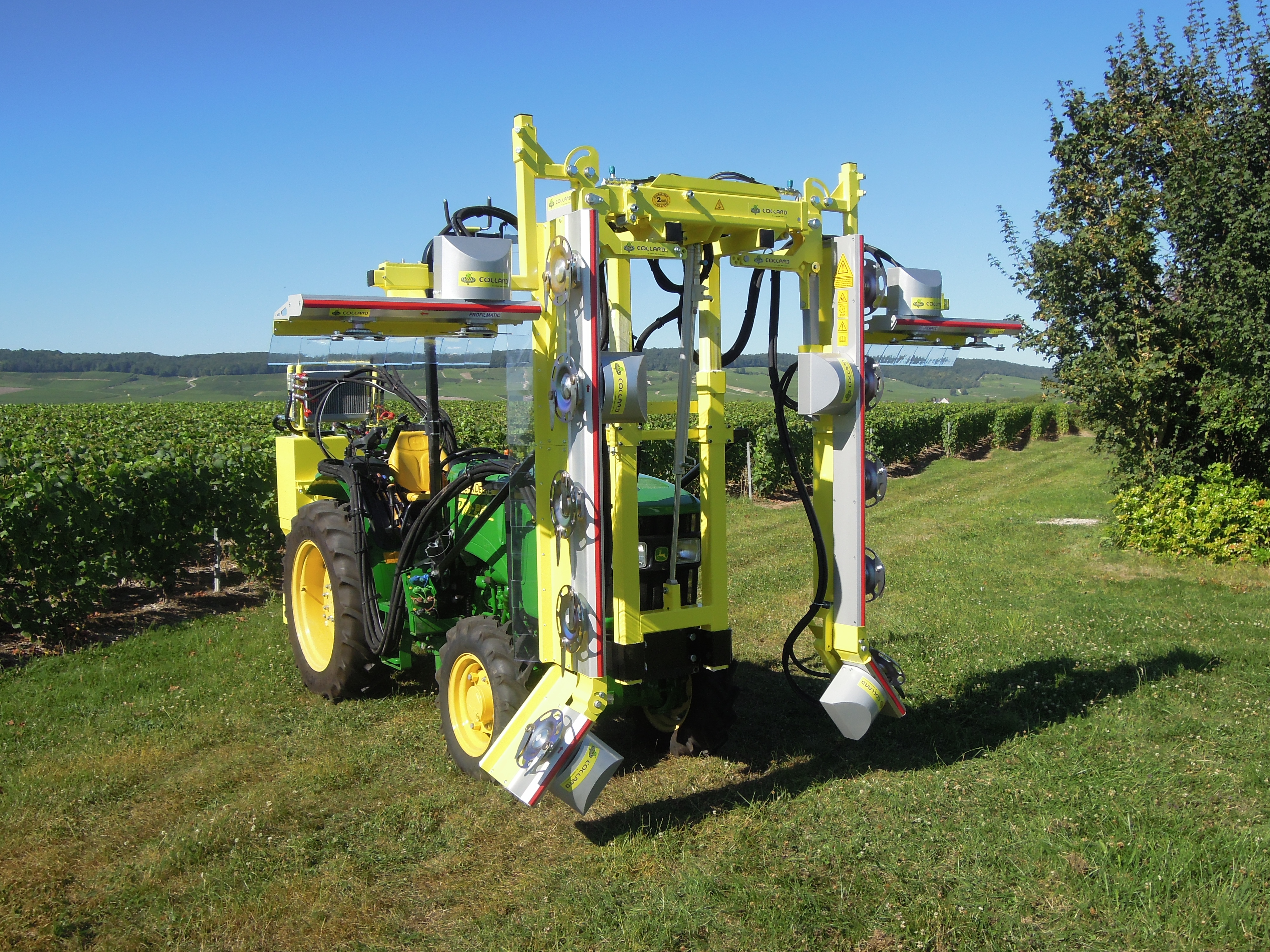One of the most challenging operations in Lodi vineyards is to pre-prune. It can be difficult to choose pre-pruning equipment since Lodi growers are using multiple different trellis systems (and sometimes also odd configurations within those trellis systems). There are two ways to break down and get to the proper pre-pruning unit needed for your vineyard operation. The first way would be to determine the style or type of pruner, and the next way would be to take a closer look at what is actually doing the pre-pruning cut.
Presented here are pre-pruning equipment styles currently being developed or used in California, along with some of their pros and cons:
#1 Margarite or barrel pre-pruners.
These units have a series of rotary blades that are stacked on a mandrel, with one mandrel on the left of the vine and one mandrel on the right of the vine. The cutting mandrels revolve close to the forward speed of the tractor and are forced together by a hydraulic cylinder, basically cutting through the brush above the cordon height. These units work well in vertical trellised vineyards. Sometimes growers can use them in bi-lateral pruned vineyards, but cross arms always become the challenge for this unit. Most of them can take up to around a 10” cross arm but after that, the unit could have trouble opening up around the wider arms. The other challenge is spur position. If your spurs are fairly vertical, you can lower the rotary blades to get pretty close to the spurs you want to prune to later. But if your vineyard has a good percentage of spurs in the more horizontal position, then the machine can do damage. Remember the mandrels crunch down on the canopy and this can pop off needed spurs if the blades are too close.
Early versions of these units were very well built but also had increased weight and needed to be balanced with counter weights. Newer versions are lighter but that takes a toll on quality at times. I’ve always recommended a crawler tractor but the widest wheel tractor that has nice flotation tires can work well. The barrel pre-pruners do have their trellis limitations, but they basically leave you with small sticks on the berm and a nice row of spurs to finish pruning with your hand crew.
#2 Profile cutters.
This description covers most of the pre-pruning currently done in Lodi. Basically, a grower will get trimmer cutting bars, mount them on a tractor, and attempt to cut close to their trellis and vine. If possible, they will cut all the way around the vine in a profile manner. Growers commonly use single sickle bars, double action sickle bars, belt style trimmer sickles, chain style sickles, rotary flail, rotary knife, or saw blades. Growers have mounted these units to everything from simple tractors up to grape harvester frames. It’s very rare to see trimmers off ATV units due to the hydraulic requirements but I have been involved in projects that do exactly that.
As we try and get closer to the vine, the profile cutters become more at risk to snag a cross arm, wire, or grape stake. But the units can be adjusted to many various positions, so growers can find a lot of benefit with all the different systems they have.
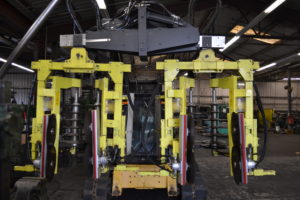
Profile saw paired with margarite arms
#3 Internal cutters.
Several companies are producing machines that have arms that will move in and out to be able to cut inside the canopy and around the grape stakes. Some use saw blades and others will use sickle bars, either rotary or straight. They are normally paired with a profile cutter. The profile cutters will take off most of the canes in preparation of the internal cutters that would be cutting closer to the cordon. This type of pre-pruner requires more mechanical effort on the part of the grower. Lots of parts and pieces and lots of oil flow may be required, but you can get closer to the spur position giving you a smaller final pruning invoice.
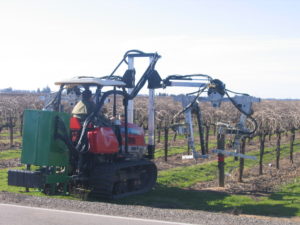
Internal canopy pre-pruner
#4 Box Pruners.
Mainly for high-wire or no prune vineyards, there are two units that fall into this category. The first being a saw cutter that profile cuts the box trellis in one pass down to the grower’s intended size. These have three saw elements that go up the side, over the top and back down the other side. The second style is a rotary sickle cutter. Sickles will cut either side and you have a rotary sickle system on retractable arms that moves in and out to clean off the top and bottom. Box pruning is still fairly new in the Lodi area. So, it’s not clear how well we can keep our “box” measurements limited to original intended size. Most growers are attempting to keep their size to about 8” square and this will become more challenging as the seasons add more and more growth.

High wire box pruner
Now, onto what type of cutter is best for your application.
#1 Single sickle bars.
By far the most common and inexpensive of all cutters, the single sickle bar is simply a hydraulically driven hay cutter. Multiple sickle knifes on a reciprocating bar cut against a fork prong. The parts are very durable and easy for the grower to work on. They can cut very thick canes with the proper hydraulic motor installed. The drawback to single sickle cutters is that they have trouble with bias cutting (cuts at an angle). They will do the cut, but they will pull the cane a bit while it’s trying to settle into the blade and fork, causing damage to spur positions. This is why most growers have to keep a certain distance from the spurs and use as a profile cutter only.
#2 Double sickle bars.
These are two reciprocating multiple cutting bars working against each other. This type performs bias cuts a bit better due to the fact that with the shorter distance to get into the cutting area, there is less pulling on the canes. These cutting bars are normally more expensive than the single sickles but have a much narrower silhouette due to the reduced size of the eccentrics.
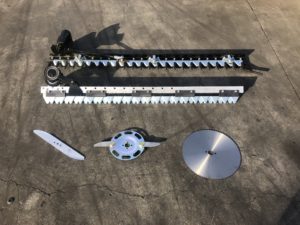
Single and double sickle bars high speed knife flail and saw
#3 Belt and chain continual trimmer bars.
Belt and chain continual trimmer bars both have sickle blades that attach to either a v-belt or a chain and the blades cut against a prong along the bar length. Both are fairly reliable units and can go at higher rates of forward speed when ran against the sickle styles. Drawbacks to the chain trimmer are its weight and physical size. The v-belt trimmer is lighter but can have slipping problems in real heavy winter cane pruning.
#4 High speed rotary knife bars.
(European style) Hydraulically driven high-speed rotary blades are placed along a straight housing to produce a certain length of cut. These are some of the fastest (rate of speed) cutters on the market. Safety is always a prime concern as well as the install price of these units. Drawbacks are that they can throw small chunks of debris back on the tractor. Open station tractor drivers require some kind of shield when running these units.
#5 High speed flail knife bars.
Exactly the same as #4 above, but the solid knife blades are replaced with break-away flail knives. When using a European style cutter, heavy canes can put a lot of wear on the belts running between the cutting blades. Flail knives breakaway and give some relief to the belts driving them.
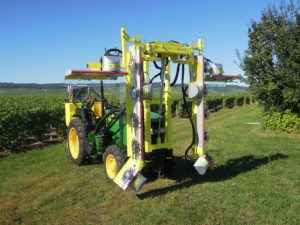
Standard trimmer set up to pre-prune using flails
#6 High speed saw blades.
Back in the early 70’s, some growers were experimenting with saw blades they would purchase at the local hardware stores. They would then mount these blades into different frames in an attempt to pre-prune vines. They had little success and to this day I still find these experiments in the backs of barns covered in dust. So why mention it now? Well things have changed. Back then you would be lucky to get a hydraulic motor to go over 500 RPM. Now, the new high-speed motors and achieve up to 4000 RPM. This has made all the difference in the world. Now as these high-speed blades go through the vineyard, a cane will basically touch the sharp blade and get severed with little damage or fraying. The cuts are clean and don’t pull on the spur positions.
They too however come with mechanical challenges. If you go up against an arm or spur, it will cut it off. That goes for grape stakes and wire as well. Trellis “strikes” can dull the blades, forcing them to be changed at regular intervals. I always recommend that there is a set of blades on the pruner, one in your truck, and one set down at the saw shop being sharpened. If they are careful, most growers can run about 4-5 days before changing out to a sharpened set.
Summary.
In summary, it is nearly impossible to find a pre-pruner that fits all trellis situations. Due to the high level of setup challenges, most tractor dealers have steered clear of dealing with pre-pruners. The local vineyard machine and fabrication shops are your best choice for reviewing all the options. Single or double row always comes into question. Double row does not always guarantee twice the productivity. The machines can be very difficult to run as the doubles are requiring a better driver and base tractor to mount to. Skid steers have become more popular due to flotation over wet ground, the high level of oil flow available, and the quick disconnect capabilities. The prime drawback with the skid steer has been visual. It’s sometimes difficult for drivers to monitor the pruning heads from the enclosed cab. Open station tractors, either wheel or crawler, offer the best viewing position but do put the operator out in the elements and driver protection needs to be added. Many companies are adding electronic sensors to help in keeping the heads on level with the cordon position. All these additions will help, but not in all situations. Please remember that the type of pre-pruner selected by the grower is only 25% of the battle for cheaper pruning costs. The other 75% of the equation is put onto vineyard floor levelness, quality of trellis, and quality of the driver.
Craig Edwards is the President of Acampo Machine Works, a vineyard equipment specialist company based in Lodi, California.
Have something interesting to say? Consider writing a guest blog article!
To subscribe to the Coffee Shop Blog, send an email to stephanie@lodiwine.com with the subject “blog subscribe.”
To join the Lodi Growers email list, send an email to stephanie@lodiwine.com with the subject “grower email subscribe” or click on “join our email list” to the right.
To receive Lodi Grower news and event promotions by mail, send your contact information to stephanie@lodiwine.com or call 209.367.4727.
For more information on the wines of Lodi, visit the Lodi Winegrape Commission’s consumer website, lodiwine.com.

